| The
Role of the Egg cell in the Formation of a New
Human Being
With the onset of puberty, there is a similarity
in the developments in the male and female bodies.
The female reproductive cell, the egg, along with
the female reproductive system is prepared to
complement the male reproductive system.
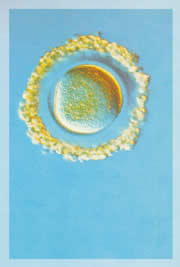 |
We
will show them Our Signs on the horizon
and within themselves until it is
clear to them that it is the truth.
Is it not enough for your Lord that
He is a witness of everything? (Qur'an,
41: 53) |
|
With the coming of puberty in women, just as
in men, the hypothalamus knows exactly when the
time has come to send commands to the pituitary
gland to produce the hormones required to bring
the egg cells to maturation. The pituitary gland
receives these commands, immediately obeys them
and begins to produce the needed hormones.
The production of reproductive cells in women
is not continuous as it is in men. This production
occurs at particular times. It is the job of the
pituitary gland to determine the time. The pituitary
gland assures the production of a hormone that
will bring the primary egg cells to maturation
in the ovary. This hormone knows very well where
it will perform its function, and going straight
to the ovary, it announces that the time has come
for the maturation of the egg. At this, the egg
cells immediately understand the command and begin
an intense activity inside the ovary, leading
to the maturation of the egg.12
Now, let us examine this information more deeply.
How does this tiny secretory gland called the
hypothalamus determine the time? And how does
it calculate the exact timing of this process,
which has occurred in millions of women past and
present, without getting confused? The hypothalamus
is located at the base of the brain; it is not
a timing mechanism, it has no relation with the
world outside the brain; it is a piece of flesh
composed of cells. The function of this piece
of flesh in determining time is an extraordinary
thing that cannot be ignored. But this is just
a tiny detail of the wondrous occurrences that
happen continuously in the human body. This kind
of astounding process continues endlessly, at
every moment and in every square millimetre of
the human body. For example, an amazing miracle
happens in the pituitary gland: a command sent
by the hypothalamus is read and understood; on
the basis of this understanding a decision is
made; according to this decision, substances are
produced and sent with other productive material
without error to a distant and hitherto unseen
area. The pituitary gland is also a collection
of cells. The coming together of these cells and
their conscious understanding of the commands
sent to them and their carrying out a command
they have understood is an extraordinary thing.
What consciousness makes it possible for this
collection of cells to "understand", "conceive",
"draw conclusions", "arrive at decisions" and
"put the decision into effect"?
The human body is a dark environment into which
light does not penetrate and where many fluids
move at great speed through the vessels; it is
a dense and complicated place. No evolutionist
has ever been able to explain how a mass of molecules
in this dense environment can go where it wants
in the complex mass by crossing over other materials
many times its own size and without suffering
harm or loss, or how they can even use some means
to send some other substances to the places where
they are needed. This is because evolutionists'
sole refuge, when they come face to face with
these marvellous proofs of creation, is chance;
but there is no room for chance in the complex
structure of the human body or of any other living
thing.
At this point, we must recall that, in the course
of all these events, the intelligence and conscience
we encounter do not belong to any cell. What we
call a cell has no eyes to see with, to tongue
to speak or be understood with, and no ears to
hear with. Cells are the creation of God; they
are only the means of carrying out His commands;
and at every moment, by His inspiration, they
effect processes too wondrous ever to have come
from themselves.
The Egg Cells Begin to Develop...
The egg is produced in an organ with every aspect
having been especially designed for this purpose:
the ovary. In every woman, there are two ovaries,
one on the right and one on the left. In these
ovaries, there is a space, big enough for nerve
fibres and blood vessels and lymphatic ducts to
enter and exit. Inside this space, there are fibrous
tissues rich in blood. For the egg cells to be
formed safely, they must be nourished and protected
by these tissues. Within this protective structure,
there are many sacs (follicles) of varying sizes.
In every follicle there is one primary egg cell.
But only a single mature ovum is normally released
from the ovaries each month so that only a single
foetus can begin to grow at a time.
But this production does not consist of only
one stage. In order for this egg cell to mature,
a few developments must occur, one after the other.
In order for the primary egg cell to maturate
and become reproductive cells, one division by
mitosis and two divisions by meiosis must occur,
and in a definite series without confusion. As
a result of the divisions, a difference in the
number of chromosomes in the cell occurs and different
types of cells are formed. As is the case with
male reproductive cells, in the female, too, the
46 chromosomes in the primary egg cells are reduced
to 23.
| 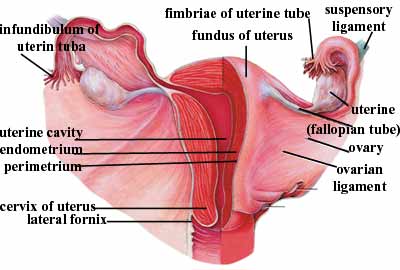 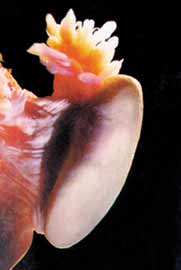
Above we see the internal structure of the
uterus. A special system has been created
in the female body that takes into account
every eventuality that may occur in the
production of the egg and in the completion
of its journey. For example, the millions
of cells in a fallopian tube are responsible
for making the egg reach the uterus. At
the side we see a picture of a fallopian
tube where the ripened egg lands.
|
As a result of the divisions by mitosis and meiosis
in the egg cell, three small cells and one large
cell (ootid) are produced. The small cells die
from lack of nourishment, while the large cell
undergoes some changes and becomes the egg. If
each of these cells were the same size, there
would not be enough of the required nourishment
for the development of the zygote at the end of
the fertilisation process. But the fact that one
of the cells has more nourishment, and the others
are small prevents such a problem from developing.
The development of the egg is not an unchecked
phenomenon that occurs randomly by itself. As
we explained at the beginning, what gives shape
to this development, as in the case of the male
reproductive system, are the hormones secreted
by the pituitary gland, which is located under
the brain. It is possible to outline the stages
in the formation of the egg and the hormones involved
in the process:
1. Follicular Growth: This is the stage in which
the egg cell begins to be formed. The primary
egg cell is found, as we said before, in what
is called the follicle. The formation of the follicle
takes about 14 days. A pituitary hormone, FSH
(follicle stimulating hormone), comes to the ovaries
in the bloodstream. This hormone is responsible
for the formation and development of the follicle
in the ovaries and the production of the egg from
the primary cell in the follicle. At the same
time, this hormone is the cause of the secretion
of the oestrogen hormone from the mature follicle.
Oestrogen is a hormone which especially affects
the uterus. It accelerates the division by mitosis
of the cells in the uterus; this area then swells
forming a soft cushion to which the embryo will
adhere after the process of fertilisation. In
addition, it ensures that a sufficient quantity
of blood and tissue fluids are directed to the
uterus. These preparations are made every month.
If an egg is fertilised, it lodges in this specially
prepared tissue where it is nourished and its
development continues.
| 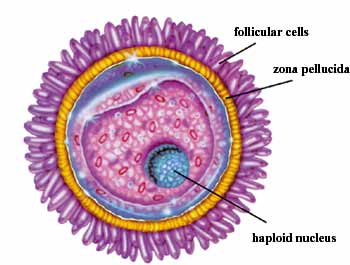
At the side we see
the representation of a tiny egg cell the
size of a grain of salt, which is one of
the most important elements that go into
the formation of a human being. The system
required for the formation of this single
cell, is found in every female alive in
the world today, as it has been found in
all females who have ever lived. This is
God's flawless creation. |
As is the case at every stage of human creation,
here also a miraculous event takes place. The
cells in the female reproductive system determine
in advance the needs of the embryo that they will
host, make preparations to meet these needs and
work to supply the most suitable environment for
the development of the foetus. How can a collection
of cells effect operations that require such a
degree of consciousness and intelligence? It is,
of course, impossible to say that cells possess
such a consciousness and intelligence, but cells
in the female reproductive system (even cells
in the pituitary gland) do these things which
we have declared impossible for them, and prepare
in advance the environment most suitable to the
needs of an embryo they have never known.
It is not possible for anyone with an intelligent
mind to claim that cells do these things by their
own will and intelligence. Indeed, only one whose
thinking is seriously flawed could claim that
cells composed of unconscious atoms can do what
he himself cannot possibly do with his conscious
intelligence. This being the case, the reality
before us is crystal clear: all the cells that
contribute toward the creation of a human being
perform their functions by the inspiration of
the Creator; they are vehicles in the realization
of a miracle that occurs when every human being
comes into the world.
2. Ovulation: At this stage the follicle that
carries the egg breaks and the egg is released.
But the egg cell, which has been released from
the ovaries into the void needs assistance. Otherwise,
the egg cell would never be able to find the place
to meet the sperm. So, at this point, the fallopian
tubes, located between the ovary and the uterus,
go into action. The egg cell, which has been released
from the ovaries into the void, is caught by the
fallopian tube, which has large tentacles like
an octopus. The fallopian tube provides an appropriate
environment for fertilisation and the later stages
occur depending on whether or not there are sperm
present in this tube.
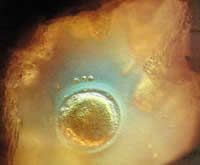
An egg cell is
150 microns in size, and is colourless
and semi-transparent. (above) It is
the shape of a sphere and its outer
part is surrounded by a soft yet tough
membrane. Within the structure of the
egg there are extra nutrients like fat,
sugar and proteins. This reserve of
nutrients will ensure that the egg cell
is nourished on its journey and, if
fertilisation occurs, will take care
of its needs until it reaches the uterus.
|
Controlling all this process is the luteinizing
hormone (LH) secreted by the pituitary gland.
It is worthwhile pointing out another interesting
thing about this hormone. The LH hormone is absolutely
necessary for the breaking of the follicle in
which is located the mature egg cell and for its
movement toward the place where it will meet the
sperm. The absence of this hormone will result
in the failure of the follicle to progress to
the stage of ovulation, even if there is no deficiency
in the secretions of the other hormones. But this
sort of problem does not occur and 2 days before
the ovulation stage, for a reason that scientists
are still unable to explain, there is an increase
in the secretion of the LH hormone from the anterior
pituitary gland. At the same stage there is an
increase in the FSH hormone and, by the influence
of these two hormones, ovulation occurs regularly
every month. In other words, here too the pituitary
gland makes an astounding calculation of time
and begins the secretion of the required hormones
at exactly the right time and in the proper quantities.

The egg cells
develop in the ovaries, in structures
called follicles. In this illustration
we see the stages of the development
of one single egg cell and its release
from the follicle. All women regularly
repeat this stage at a particular time.
Every month during a particular period,
new egg cells are formed and the same
hormones are secreted again and again
as the female body prepares itself as
if fertilisation were about to occur.
But in the final period of this preparation,
the preparations change according to
whether or not sperm are present. This
is an evident miracle of creation.
|
Of course this conscious activity is not to be
expected from the pituitary gland itself or from
the cells which make up this gland. Since there
is a superior intelligence and will to be seen
here, there is One to Whom this intelligence and
will belong: it is the intelligence and will of
God which reveals itself in all of these wondrous
occurrences in the stages of human creation.
3. The Corpus Luteum (yellow body) - The Luteal
Phase: After expulsion of the egg from the follicle,
the empty follicle fills with blood. There are
special cells called "granulosa" and "theca" cells,
which surround the empty space where these follicles
are located; they multiply and take the place
of the clotted blood in the follicle. These cells
accumulate yellow lipid, and are therefore called
lutein cells, from the Latin word luteus, "saffron-yellow."
So, the follicle from which the egg has been released
swells with the fluids which have filled it and
becomes an active element called the corpus luteum
(yellow body).13 The
corpus luteum plays an important role in the preparation
of the uterus for the embryo and in conducting
the pregnancy in a healthy manner. The most important
particularity of this element is the secretion
of the hormone called progesterone under the influence
of LH (luteinizing hormone). Progesterone has
an extremely important function in stimulating
the walls of the uterus. The most important change
in the uterus occurs in the mucous membrane (mucous)
that lines the uterus. Under the influence of
oestrogen and progesterone, the mucous membrane
begins to swell. The glands and blood vessels
become highly tortuous, and the thickness of the
uterine wall increases. The purpose of these changes
is to prepare a suitable place for the embryo
after fertilisation. In addition, it allows the
pregnancy to advance by making the walls of the
uterus relax. Progesterone also affects the development
of the milk glands.
That one hormone can have an influence on another
and that they have the sense to do these things
exactly at the right time cannot be explained
by the operation of chance. This brings some questions
to mind: How can a molecule formed of unconscious
atoms be possessed of such a sensitive innate
power and take the initiative to organize the
operations of the body so comfortably? It is clear
that the molecules that make up the hormones do
not have intelligence or consciousness. This shows
that the system together with its complementary
character has been created by a supreme power.
It is God, Lord of earth and heaven Who has inspired
the molecules which compose the hormones and the
atoms which compose the molecules in their conscious
activities.
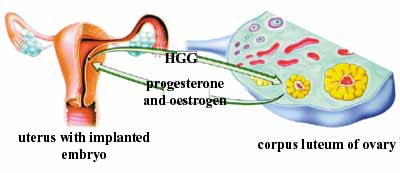
When the egg
is released from the follicle, the corpus
luteum is formed and begins to secrete
oestrogen and progesterone. Progesterone
stimulates the walls of the uterus.
Under the influence of these hormones,
changes occur in the wall of the uterus.
The purpose of these changes is to prepare
a suitable environment where the embryo
may lodge after fertilisation. All these
operations occur in all women in the
same sequence and with the same perfection.
These operations are the result of an
evident plan and design.
|
The corpus luteum phase lasts 12-14 days. At
the end of this period, if fertilisation has not
taken place, the corpus luteum degenerates and
the same stage is repeated. With the degeneration
of the corpus luteum, oestrogen, progesterone
and other hormones are no longer secreted; that
is, the pituitary gland again comes into action.
Once again the secretion of FSH and LH begins
in the pituitary gland, causing the growth of
new follicles to begin. But these follicles cannot
develop sufficiently because the lack of oestrogen
and progesterone causes a new stage to begin-menstruation.
4. Menstruation: This is the stage in which the
unfertilised egg is ejected from the body. Because
fertilisation has not taken place, the previously
prepared wall of the uterus contracts, the blood
vessels are constricted and the egg is ejected.
After this stage, the body will begin again to
prepare to carry out all these functions.
It was He Who
created the heavens and the earth in
all truth. The day He says "Be!" it
is. His word is the Truth. All sovereignty
shall be His on the Day the Trumpet
is blown. He is the Knower of the Unseen
and the Visible. He is the All-Wise,
the All-Aware. (Qur'an, 6: 73)
|
This whole stage is repeated in all women regularly
throughout a particular period of time. Every
month new egg cells are produced, the same hormones
are secreted again and again at the same period
and the woman's body is prepared as if fertilisation
were going to occur. But in the final stage, the
direction of the preparation changes according
to whether or not sperm are present.
Preparations for Fertilisation
 sperm moving in
the mucous
sperm moving in
the mucous |
The egg cell is 20-25 cm. from the place where
the sperm enters the female body. This distance
is about 3000 times the size of the sperm. Considered
in proportion to its own size, this distance is
quite large and to traverse it the sperm needs
strong support.
Before the egg can meet the sperm, some preparations
begin in both the male and the female body. The
great majority of these preparations are to protect
the sperm on its journey in the mother's body.
For example, in the uterus various contractions
and undulations occur. This uncommon activity
in the uterus and fallopian tubes facilitates
the sperm's advance towards the egg. The interesting
thing about these contractions is the substance
that causes them. This substance is called prostaglandin
and is found in the seminal vesicle fluid that
comes with the sperm from the male body. Despite
the fact that it comes from a different body,
this substance knows the structure of the mother's
uterus and affects it in such a way as to make
the way easier for the sperm.14
In order for fertilisation to take place, the
changes that take place in the uterus are not
limited to these. During this period the tubes
expand; under the influence of the oestrogen hormones,
the mucous membrane that lines the uterus increases
in size and weight. The epithelial cells membranous
tissues composed of one or more layers of cells
separated by very little intercellular substance
proliferate. This structure in the mucous assumes
a shape that will permit the sperm to pass through
these spaces with the movement of its tail. Besides
allowing the sperm to move easily, this transformation
has another very important function: the tissues
serve as a storage and filter area, allowing only
normal sperm to pass. Sometimes the sperm do not
have a shape that can ensure fertilisation. In
this case, they are suspended in these tissues.
 The sperm have a
resilient structure to enable them to
endure the long and arduous journey in
the mother's body. But as we can see in
the picture on the left, some sperm are
impaired. By design, impaired sperm are
eliminated as they travel in the mother's
body, while healthy sperm are detected
and guided to the egg. Thus, the egg always
unites with a healthy sperm.
The sperm have a
resilient structure to enable them to
endure the long and arduous journey in
the mother's body. But as we can see in
the picture on the left, some sperm are
impaired. By design, impaired sperm are
eliminated as they travel in the mother's
body, while healthy sperm are detected
and guided to the egg. Thus, the egg always
unites with a healthy sperm. |
As can be seen from the foregoing, it is evident
that every movement in the uterus and ovaries
is specially designed for the sperm to reach the
egg cell. For example, after ovulation has occurred
and the possibility for an egg to meet a sperm
has been ensured, the mucous begins to perform
a reverse operation: it becomes thick and dense,
preventing the sperm from entering.
The reason for the changes that happen in the
female reproductive system is to allow the sperm
which enter the body to reach the egg (ovum).
But, as we saw above and in the previous section,
this is a matter of great interest: the elements
in the female reproductive system assist cells
coming from a totally different body.
How can it be that a cell has come to have so
much detailed information about other cells with
which it has never even shared the same environment?
(even if they had shared the same environment
the result would not be different.) How does it
know, for example, that the movement of these
cells must be facilitated? Indeed, it is not possible
for the cells that produce the fluid in the uterus
to know the qualities possessed by sperm or to
prepare a suitable environment for them.
All the functions we have described up to this
point occur in all women in the same perfect sequence.
When we consider the operation of these harmonious
and complementary systems, we come face to face
with an evident plan and design: the sperm is
designed for the mother's body; the mother's reproductive
organs are especially ordered to accommodate the
sperm. If there is the slightest defect in this
harmony, for example, if the sperm does not have
the tail that allows it to move, or if it lacked
the fluid to balance the acidic environment in
the mother's body, reproduction will not occur.
This clearly shows that the great harmony that
exists between the male and female reproductive
cells is the work of a deliberate and planned
creation. It is Almighty God, the Lord of the
universe Who has created mankind from a drop of
fluid, male and female, in harmony with each other.
Human beings should consider the perfection of
God's creation and submit themselves unconditionally
to Him, bowing before the eternal power of the
Lord.
And in your creation and
all the creatures He has spread about, there are
Signs for true believers. (Qur'an, 45: 4)
| Conscious
Movements of the Fallopian Tube |
 After
maturating and being released, as
we explained earlier, the egg is intercepted
by the fallopian tube. If the egg
cell, when released by the ovary,
is not intercepted by the fallopian
tube, it passes into other parts of
the mother's body where it cannot
meet a sperm. After
maturating and being released, as
we explained earlier, the egg is intercepted
by the fallopian tube. If the egg
cell, when released by the ovary,
is not intercepted by the fallopian
tube, it passes into other parts of
the mother's body where it cannot
meet a sperm. The
fallopian tube is where the egg
and the sperm meet. In order to
ensure the meeting, the fallopian
tube performs a two-fold activity;
first, it takes the maturated egg
cell from the ovary and guides it
to the place in the tube where it
will meet the sperm. Secondly, it
takes the sperm from the cavity
of the uterus and brings it to the
place where it will meet the egg.
First of all, the
fallopian tubes, which are located
beside each ovary, collect all the
eggs released from the ovary. The
ends of the fallopian tubes are
like arms which surround the ovary
and are designed to collect the
maturated eggs. When the eggs have
come to maturity, the arms of the
fallopian tubes open and, like the
arms of an octopus, they grasp the
surface of the egg and begin to
move over it with a sweeping motion.
Aided by these activities, at the
time of ovulation the egg falls
into the fallopian tube. The egg,
released into the pelvic cavity,
enters the fallopian tube which
is 10-12 cm. in length. The inside
of the fallopian tube is covered
with millions of tiny hairs which
move in one direction, drawing the
egg to where it will meet the sperm.1
By this time, the
follicle cells surrounding the ovum
at the time of ovulation still remain
as an outer envelope. The folded
mucous membrane of the egg secretes
enzymes which gradually cause this
cellular envelope to loosen. Thus,
the follicle cells are "rinsed away",
so that the protective membrane
of the egg lies exposed to the sperm.
The timing of these
operations performed by the fallopian
tube is very important, because
both the sperm and the egg cell
have a limited life-span. It is
necessary that the sperm cells reach
the egg cell before this life-span
expires. How does the fallopian
tube make the adjustments for this?
How does it know how long the alien
cells can survive? Certainly a piece
of flesh, a few centimetres in size,
could not have the information or
skill to perform these operations.
As is the case with every cell and
tissue, the fallopian tube performs
its activity only by the inspiration
of God, the Creator of all the worlds.
For this reason, it carries out
this difficult activity easily and
without a hitch. So, it becomes
possible for the egg cell to be
fertilised before it dies, that
is, within 24 hours at the most.
1- Lennart Nilsson,
A Child is Born, Delacorte Press,
NY, 1977, p. 22 |
|
The Sperm Meets the Egg
After undergoing many processes on the way to
maturation, the egg is released from the fallopian
tubes. At this time, it carries with it many cells
surrounding it. Before the egg can be fertilised,
the sperm which reach the fallopian tubes must
pass through these cells, which are called "granulosa"
cells, and then penetrate the thick mantle around
the egg.
How will the sperm pass through these obstacles?
| The
Egg's Journey in the Falllopian
Tube |
 |
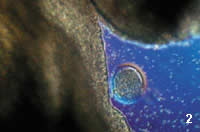 |
Just
before the maturated egg is released
from the ovary, the fallopian tube
goes into action to intercept the
egg. With delicate touches on the
surface of the ovary, it tries to
find the egg cell. (1-2) In order
for the maturated egg to be fertilised,
it must enter the fallopian tube.
Finally, the fallopian tube finds
the maturated egg and draws it inside.
Now, the egg cell starts its journey.
(3) In order for the egg to be fertilised
and reach the mother's uterus, it
must travel a long road in the fallopian
tube. It is the function of the millions
cells in the fallopian tube to guide
the egg to the uterus. The tiny hairs
on the surface of these cells (cilia)
move in only one direction. In this
way, as if they were actually conveying
a precious object from hand to hand,
they urge the egg cell to the place
where it has to go. Finally, the egg
meets the sperm which are seeking
it. (4) Only one sperm succeeds in
entering the egg. (5) The fertilised
egg is directed toward the mother's
uterus with the help of the tiny hairs
in the fallopian tube (6). Every cell
performs its duty flawlessly, because
God's creation is perfect. |
 |
 |
 |
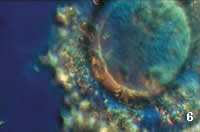 |
|
Here we see once again the evident perfection
of intelligent design in the sperm. In that section
of the sperm called the "acrosome", about which
we spoke earlier, the hyaluronidase and proteolytic
enzymes are stored. The hyaluronidase enzyme in
the acrosome breaks down a substance (hyaluronic
acid) binding the multiple layers of granulosa
cells attached to the outside of the ovum. In
this way, it opens a way for the sperm to traverse
the egg envelope. The proteolytic enzymes ensure
the dissolution of the proteins in the tissues
attached to the egg. With the help of these two
enzymes, the sperm reaches the egg.15
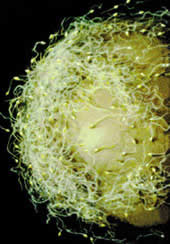 |
Your
god is God alone, there is no
god but Him. He encompasses all
things in His knowledge. (Qur'an,
20: 98) |
An egg cell
surrounded by sperm
|
|
How is it that these enzymes which belong to
the sperm, produced in the male body far away
from the egg, are composed of matter that is perfectly
able to affect the structure of the egg? Who discovered
the formula for this operation? Who placed these
enzymes exactly in the right place to enable the
fertilisation of the egg; that is, in the head
of the microscopic sperm?
It is not the sperm itself which does these things.
It is not possible for the sperm to be aware of
the existence of hyaluronic acid or the effect
this acid has on cells, or to know that the hyaluronidase
enzyme will neutralize the effect of this acid.
Moreover, it is not sufficient to know the formula
of this acid; its production in the human body
must also be ensured. And it is impossible for
the sperm by itself to form the system in the
human body which will produce this enzyme. For
example, if you ask anyone who has not had training
in medicine or chemistry the name of the enzyme
that destroys the structure of hyaluronic acid,
or if you asked him to write the formula of the
structure of this acid, he would certainly not
be able to give you an answer. But a sperm cell
does things that a conscious human would not be
able to do; with a seeming awareness of chemical
formulas which it could not, however, know, it
contains substances within its own body to ensure
reaching its goal. Certainly, to say that the
sperm does this is completely contrary to intelligence
and reason. Leaving aside unintelligent and unreasonable
suppositions, it will be seen that the presence
in sperm of enzymes that will affect the structure
of the egg is in itself a proof of creation. This
flawless harmony cannot be explained in any way
by reference to chance. The fact that the sperm
is aware of the chemical structure of another
cell different from itself and living in a completely
different environment; that it analyses the effects
that these chemicals will have; that it then produces
the required chemicals acco
rding to the results of the analysis, can be
explained only with reference to a Creator with
superior intelligence, Who has created the sperm
with these particular qualities.
The perfect design in the structure of sperm
is one of the plainest proofs of the fact that
God created human beings, together with everything
else.
The Sperm Continues its Journey
When the sperm reaches the outer layer of the
egg, its outer membrane binds tightly to the surface
receptors on the egg. When this binding occurs,
the sperm sheds its outer covering (acrosome).
At the same time, the membrane of the egg secretes
a substance called "fertilizin," which is required
to attract the sperm. This molecule makes the
sperm able to move more quickly, allowing them
to react with the egg membrane more easily. In
addition, fertilizin facilitates the reaction
of the acrosome found in the head of the sperm.
When the sperm touches the egg membrane, new
substances come into play and new reactions take
place. When the sperm touches the egg, it secretes
a substance called "anti-fertilizin" which neutralizes
the effect of the fertilizin secreted by the egg.
In this way, the first sperm to reach the egg
will stop other sperm from approaching the egg.16
The membrane which surrounds the egg cell begins
to renew itself about two seconds after the sperm
cell enters and never allows another sperm cell
to enter. Experiments have been done in which
a few sperm have been observed entering the egg
when the membrane has been destroyed. For this
reason it is necessary that the fertilisation
membrane be formed as quickly as possible. After
the formation of the fertilisation membrane, no
sperm can enter the egg. In this condition, it
is possible to compare the egg cell to a building
protected by security. The outer membrane of the
egg cell really acts like the security control
system of a building which contains very important
information; access is denied to the inside of
the cell.
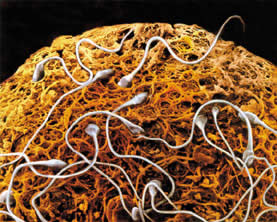 |
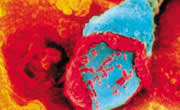 |
In
the large picture we see an egg cell
surrounded by sperm; in the small
pictures, a number of sperm cells.
The sperm have special characteristics
that allow them to interact with the
structure of the egg. Just one of
these characteristics, for example,
the existence of enzymes which allow
the sperm to pierce the whole defensive
system of the egg and enter it, is
by itself a proof of creation. God
created the sperm with all their special
characteristics in an instant. |
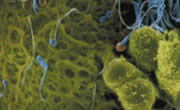 |
|
Once a sperm enters the ovum, its head swells
and it wanders very slowly toward the centre of
the egg. Later, within 30 minutes, the egg completely
unites with the sperm inside it. As a result of
all these processes, the genetic information contained
in the sperm is transferred to the egg.17
But here there is an important point: if the
receptors on the sperm and the egg accept one
another, they bind to each other; if not, binding
is not possible. The reason for this is as follows:
the egg of every living being secretes a substance
called fertilizin, which has a particular chemical
composition. This is a precaution which prevents
sperm cells of other species (non-human species)
from approaching the egg and causing the degeneration
of the human species. Thus, a cat cannot mate
with a horse and a human being cannot mate with
any other living thing.18
The electrical charge carried by the sperm and
the egg also has an effect on fertilisation. The
egg always carries a negative charge and the sperm
carries a positive one. Because opposite charges
attract each other, the egg draws all the sperm
towards itself. But with the first sperm that
is able to enter the egg, the charge changes immediately.
Now the egg assumes a positive charge like the
sperm's. Because like charges repel each other,
at the moment of union the egg begins to repel
all other sperm.19
The Last Stage of Fertilisation
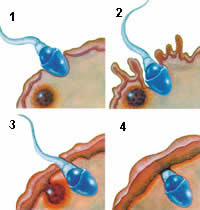 When the sperm reach
the egg, only one of them succeeds in
penetrating its protective membrane. (1)
When the sperm enters the egg, certain
changes occur and the egg closes itself
to other sperm. (2-3) Once it enters the
egg, the sperm's tail breaks off and remains
outside. (4) Fertilisation occurs.
When the sperm reach
the egg, only one of them succeeds in
penetrating its protective membrane. (1)
When the sperm enters the egg, certain
changes occur and the egg closes itself
to other sperm. (2-3) Once it enters the
egg, the sperm's tail breaks off and remains
outside. (4) Fertilisation occurs. |
When the sperm enters the egg, it sheds its tail
and leaves it outside. We may compare this to
a space shuttle which detaches its fuel tank when
returning to earth. As we know, when the fuel
tanks which carry the shuttle outside the earth's
atmosphere have fulfilled their purpose, they
are released into space; when the fuel inside
them is used up, the tanks are an unnecessary
weight. To facilitate leaving the earth's atmosphere,
it is necessary that these tanks be released at
exactly the right time. In the same way, the tail
of the sperm, which provides the required energy
and movement capability, is left behind as the
sperm attempts to enter the egg.
It is obvious to the attentive reader that fertilisation
is a highly calculated and systematic process.
Very slowly the fluids which surround the egg
dissolve the sperm's armour as it reaches the
outer membrane surrounding the egg. The enzymes
that are released at the moment the sperm's armour
is perforated allow the sperm to pierce the egg's
outer membrane and enter. The change in the electric
charge at this moment repels other sperm and protects
the newly developing organism from uninvited guests.
If such a highly protective and cooperative system
had not been created, the union of the sperm and
the egg would never have been achieved.
If the egg cell had not secreted the guiding
fluid, it would not have been possible for the
sperm to reach the egg, which is so distant from
it relative to its own size.
If the sperm had not had its armour, they, like
other microorganisms, would have been dissolved
in the fluid surrounding the egg.
If special dissolving enzymes had not been placed
beneath this armour, the sperm would never have
been able to enter the egg, even after having
gone so far as to reach it.
If the electric charges of the sperm and the
egg had been the same and not opposite, the egg
would have repelled the sperm and no sperm would
have entered the egg.
As we can see, in the union of a single sperm
with an egg, there is an extraordinary balance
and calculation. Furthermore, this balance and
calculation have occurred not just once; they
have been repeated time and again since the beginning
of the human race for every one of the millions
of individuals spread throughout the world.
Even in one single stage there is no room for
chance in this miraculous process, which shows
very plainly that God created human beings.
Everyone in the heavens
and earth belongs to Him. All are submissive to
Him. It is He Who originated creation and then
regenerates it. That is very easy for Him. His
is the most exalted designation in the heavens
and the earth. He is the Almighty, the All-Wise.
(Qur'an, 30: 26-27)
| |
|
The
moment the sperm enters the egg, it
sheds its tail. In the pictures above,
we see, stage by stage, the breaking
off of the tail of a sperm that has
managed to enter an egg. This occurs
because the continual movement of
the tail inside the egg would soon
damage it. This breaking off of a
sperm's tail can be compared to the
jettisoning of fuel tanks and engines
no longer needed by missiles and shuttles
as they leave the earth's atmosphere
on their way into space. The fact
that the sperm takes account of something
like this and detaches its tail in
time, so as not to damage the egg,
is a sign of a highly conscious activity.
The One Who makes this sperm act in
this conscious manner is God, the
Creator of the sperm and the egg. |
| |
|
|
| The
Determination of the Baby's Sex |
 Until
recently, people believed that a baby's
sex was determined by the mother's cells,
or, at least, that the sex was determined
by cells from both the mother and the father.
But in the Qur'an there is a different account
of this matter; it says that maleness and
femaleness are created from sperm entering
the womb: Until
recently, people believed that a baby's
sex was determined by the mother's cells,
or, at least, that the sex was determined
by cells from both the mother and the father.
But in the Qur'an there is a different account
of this matter; it says that maleness and
femaleness are created from sperm entering
the womb:
He (God) has created
both sexes, male and female, from a drop
of semen which has been ejected. (Qur'an,
53: 45-46)
The truth of this revelation
of the Qur'an has been confirmed scientifically
by developments in genetics and microbiology.
It is now understood that sex is determined
by the male sperm and that the female egg
plays no role in this determination. What
determines sex is chromosomes. Of the 46
chromosomes that determine the human structure,
two are called sex chromosomes. These two
chromosomes are labelled XY in males and
XX in females, because the respective chromosomes
resemble these letters. The Y chromosome
carries male genes and the X chromosome
carries female genes. The formation of a
human being begins with the union of one
of each of these chromosomes which are present
in pairs in the male and female. During
ovulation in the female, the sex cell divides
into two, each carrying the X chromosome.
In males, the sex cell divides into two
sperm, one carrying the X chromosome and
the other carrying the Y chromosome. If
the X chromosome in the female unites with
a sperm carrying the X chromosome, the baby
will be a girl; if it unites with a sperm
containing the Y chromosome, the baby will
be a boy.
That is, the sex of the
baby depends on which chromosome in the
male unites with the female egg.
Certainly, until the science
of genetics appeared, that is, until the
twentieth century, these facts were unknown.
In many cultures it was generally believed
that a baby's sex was determined by the
female. Precisely for this reason, a woman
who gave birth to a girl was condemned.
However, in the Qur'an, 13 centuries before
the discovery of genes, this superstition
was rejected by the revelation that the
origins of sex do not come from the female,
but from the semen of the male.
The Qur'an is the word
of God, the Lord of all the worlds. Such
scientific miracles are among the evidence
of this fact.
It is a Book We have
sent down to you, full of blessing, so let
people of intelligence ponder its Signs
and take heed. (Qur'an, 38: 29) |
| 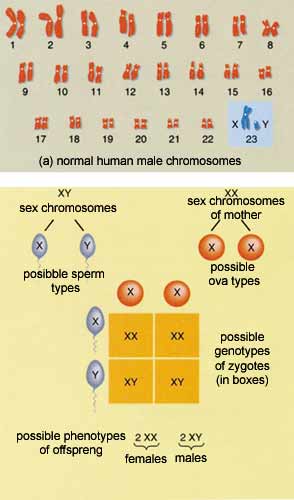
The sex of a baby depends on which male
chromosome unites with the female egg. Of
the 23 pairs of chromosomes (that is, 46
individual chromosomes), 2 are called sex
chromosomes. These two chromosomes are designated
as XY in the male and XX in the female.
The Y chromosome carries male genes, the
X chromosome, female genes. The formation
of a human body begins with the union of
one of each of these chromosomes, which
are present in pairs in males and females
(left). If the X chromosome in the female
unites with the sperm containing the X chromosome
in the male, the baby will be a girl; if
it unites with the sperm containing the
Y chromosome in the male, the baby will
be a boy. (Gerard J. Tortora, Introduction
to the Human Body: Essentials of Anatomy
& Physiology, pp. 569-570) |
|
